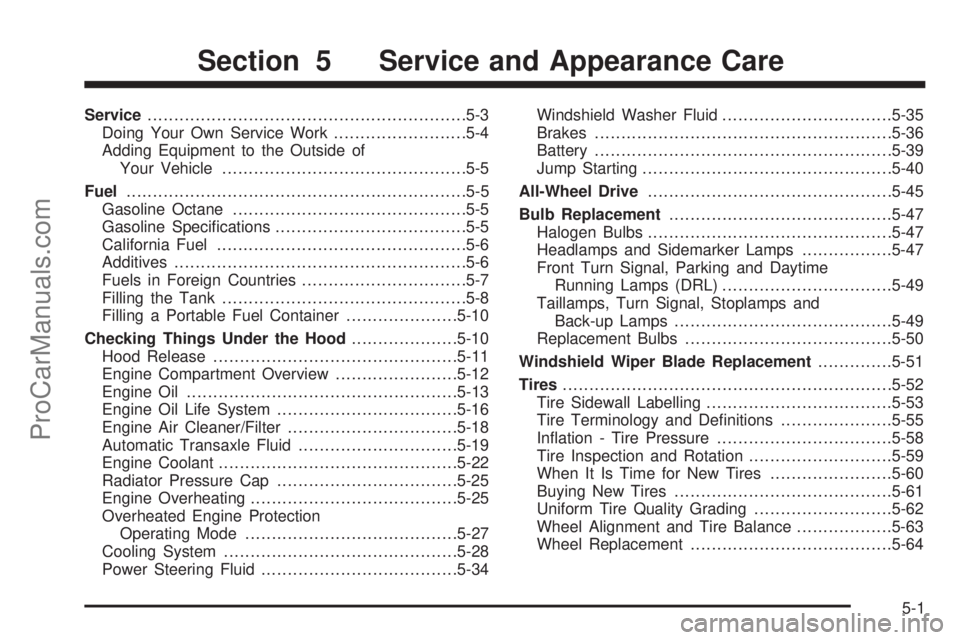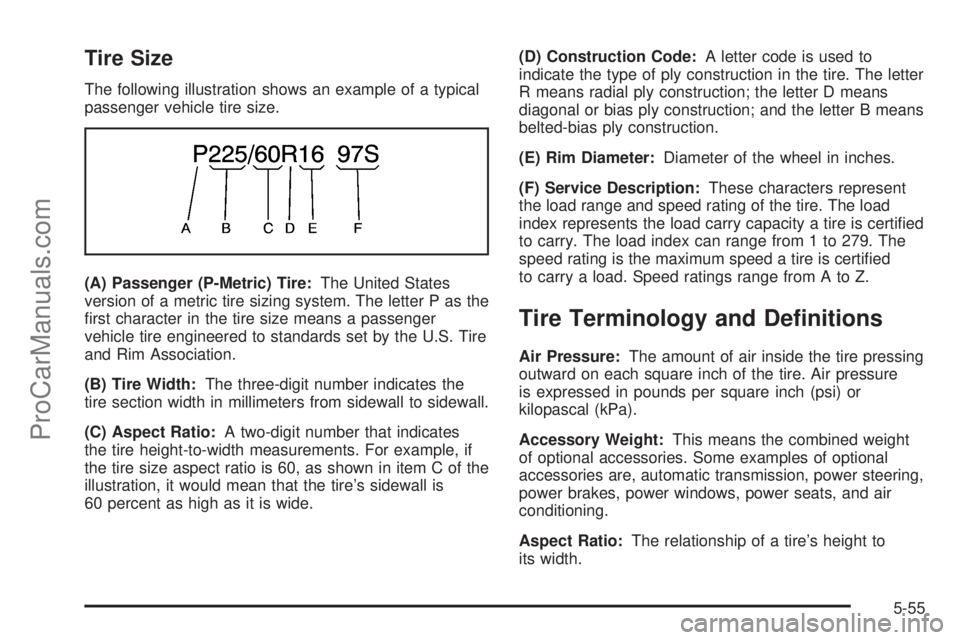steering wheel SATURN RELAY 2005 Owner's Manual
[x] Cancel search | Manufacturer: SATURN, Model Year: 2005, Model line: RELAY, Model: SATURN RELAY 2005Pages: 446, PDF Size: 3.03 MB
Page 301 of 446

Service............................................................5-3
Doing Your Own Service Work.........................5-4
Adding Equipment to the Outside of
Your Vehicle..............................................5-5
Fuel................................................................5-5
Gasoline Octane............................................5-5
Gasoline Speci�cations....................................5-5
California Fuel...............................................5-6
Additives.......................................................5-6
Fuels in Foreign Countries...............................5-7
Filling the Tank..............................................5-8
Filling a Portable Fuel Container.....................5-10
Checking Things Under the Hood....................5-10
Hood Release..............................................5-11
Engine Compartment Overview.......................5-12
Engine Oil...................................................5-13
Engine Oil Life System..................................5-16
Engine Air Cleaner/Filter................................5-18
Automatic Transaxle Fluid..............................5-19
Engine Coolant.............................................5-22
Radiator Pressure Cap..................................5-25
Engine Overheating.......................................5-25
Overheated Engine Protection
Operating Mode........................................5-27
Cooling System............................................5-28
Power Steering Fluid.....................................5-34Windshield Washer Fluid................................5-35
Brakes........................................................5-36
Battery........................................................5-39
Jump Starting...............................................5-40
All-Wheel Drive..............................................5-45
Bulb Replacement..........................................5-47
Halogen Bulbs..............................................5-47
Headlamps and Sidemarker Lamps.................5-47
Front Turn Signal, Parking and Daytime
Running Lamps (DRL)................................5-49
Taillamps, Turn Signal, Stoplamps and
Back-up Lamps.........................................5-49
Replacement Bulbs.......................................5-50
Windshield Wiper Blade Replacement..............5-51
Tires..............................................................5-52
Tire Sidewall Labelling...................................5-53
Tire Terminology and De�nitions.....................5-55
In�ation - Tire Pressure.................................5-58
Tire Inspection and Rotation...........................5-59
When It Is Time for New Tires.......................5-60
Buying New Tires.........................................5-61
Uniform Tire Quality Grading..........................5-62
Wheel Alignment and Tire Balance..................5-63
Wheel Replacement......................................5-64
Section 5 Service and Appearance Care
5-1
ProCarManuals.com
Page 355 of 446

Tire Size
The following illustration shows an example of a typical
passenger vehicle tire size.
(A) Passenger (P-Metric) Tire:The United States
version of a metric tire sizing system. The letter P as the
�rst character in the tire size means a passenger
vehicle tire engineered to standards set by the U.S. Tire
and Rim Association.
(B) Tire Width:The three-digit number indicates the
tire section width in millimeters from sidewall to sidewall.
(C) Aspect Ratio:A two-digit number that indicates
the tire height-to-width measurements. For example, if
the tire size aspect ratio is 60, as shown in item C of the
illustration, it would mean that the tire’s sidewall is
60 percent as high as it is wide.(D) Construction Code:A letter code is used to
indicate the type of ply construction in the tire. The letter
R means radial ply construction; the letter D means
diagonal or bias ply construction; and the letter B means
belted-bias ply construction.
(E) Rim Diameter:Diameter of the wheel in inches.
(F) Service Description:These characters represent
the load range and speed rating of the tire. The load
index represents the load carry capacity a tire is certi�ed
to carry. The load index can range from 1 to 279. The
speed rating is the maximum speed a tire is certi�ed
to carry a load. Speed ratings range from A to Z.
Tire Terminology and De�nitions
Air Pressure:The amount of air inside the tire pressing
outward on each square inch of the tire. Air pressure
is expressed in pounds per square inch (psi) or
kilopascal (kPa).
Accessory Weight:This means the combined weight
of optional accessories. Some examples of optional
accessories are, automatic transmission, power steering,
power brakes, power windows, power seats, and air
conditioning.
Aspect Ratio:The relationship of a tire’s height to
its width.
5-55
ProCarManuals.com
Page 368 of 446

If a Tire Goes Flat
It is unusual for a tire to blowout while you are driving,
especially if you maintain your tires properly. If air
goes out of a tire, it is much more likely to leak out
slowly. But if you should ever have a blowout, here are
a few tips about what to expect and what to do:
If a front tire fails, the �at tire will create a drag that
pulls the vehicle toward that side. Take your foot off the
accelerator pedal and grip the steering wheel �rmly.
Steer to maintain lane position, and then gently brake to
a stop well out of the traffic lane.
A rear blowout, particularly on a curve, acts much like a
skid and may require the same correction you would
use in a skid. In any rear blowout remove your foot from
the accelerator pedal. Get the vehicle under control
by steering the way you want the vehicle to go. It may
be very bumpy and noisy, but you can still steer. Gently
brake to a stop, well off the road if possible.{CAUTION:
Lifting a vehicle and getting under it to do
maintenance or repairs is dangerous without
the appropriate safety equipment and training.
The jack provided with your vehicle is
designed only for changing a �at tire. If it is
used for anything else, you or others could be
badly injured or killed if the vehicle slips off
the jack. Use the jack provided with your
vehicle only for changing a �at tire.
If a tire goes �at, the next part shows how to use your
jacking equipment to change a �at tire safely.
5-68
ProCarManuals.com
Page 399 of 446

Fuses Usage
1 Trunk, Door Locks
2 Electronic Level Control
3 Rear Wiper
4 Radio Ampli�er
5 Interior Lamps
6 OnStar
®
7 Keyless Entry Module
8Cluster, Heating, Ventilation,
Air Conditioning
9 Cruise Switch
10 Steering Wheel Illumination
11 Power Mirror
12 Stoplamp, Turn Lamps
13 Heated Seats
14 Blank
15 Electronic Level Control
16 Heated Mirror
17Center High-Mounted Stoplamp,
Back-up Lamps
18 Blank
Fuses Usage
19 Canister Ventilation
20 Park Lamps
21 Power Sliding Door
22 Blank
23 Blank
24 Left Power Sliding Door
25 Right Power Sliding Door
Relays Usage
26 Blank
27 Blank
28 Park Lamps
29 Retained Accessory Power
30 Rear Defog
PLR Fuse Puller
Circuit
BreakersUsage
31 Power Seats
32 Power Window
5-99
ProCarManuals.com
Page 434 of 446

Audio System(s).............................................3-72
Audio Steering Wheel Controls....................3-109
Care of Your CD and DVD Player................3-111
Care of Your CDs and DVDs.......................3-111
Fixed Mast Antenna...................................3-111
Radio with CD............................................3-73
Rear Seat Audio (RSA)...............................3-106
Setting the Time..........................................3-72
Theft-Deterrent Feature...............................3-109
Understanding Radio Reception...................3-110
XM™ Satellite Radio Antenna System...........3-111
Automatic Door Locks.....................................2-13
Automatic Transaxle
Fluid..........................................................5-19
Operation...................................................2-33
B
Battery..........................................................5-39
Run-Down Protection...................................3-19
Before Leaving on a Long Trip.........................4-23
Brake
Anti-Lock Brake System (ABS)........................ 4-6
Emergencies................................................ 4-8
Parking......................................................2-37
System Warning Light..................................3-35
Brakes..........................................................5-36
Braking........................................................... 4-5
Braking in Emergencies..................................... 4-8Break-In, New Vehicle.....................................2-30
Bucket Seats, Rear........................................... 1-8
Bulb Replacement...........................................5-47
Front Turn Signal, Parking and Daytime
Running Lamps........................................5-49
Halogen Bulbs............................................5-47
Replacement Bulbs......................................5-50
Taillamps, Turn Signal, Stoplamps and
Back-up Lamps........................................5-49
Buying New Tires...........................................5-61
C
California Fuel.................................................. 5-6
Canadian Owners................................................ ii
Capacities and Speci�cations..........................5-103
Captain Chairs, Rear.......................................1-14
Carbon Monoxide...................2-21, 2-40, 4-26, 4-38
Care of
Safety Belts................................................5-91
Your CD and DVD Player...........................3-111
Your CDs and DVDs..................................3-111
Cargo Lamp...................................................3-19
Chains, Tire...................................................5-65
Charging System Light....................................3-35
Check
Engine Light...............................................3-38
Checking Things Under the Hood......................5-10
Chemical Paint Spotting...................................5-94
2
ProCarManuals.com
Page 444 of 446

Spare Tire
Accessory In�ator........................................5-66
Compact....................................................5-87
Installing....................................................5-73
Removing...................................................5-70
Storing.......................................................5-82
Speci�cations, Capacities...............................5-103
Speedometer..................................................3-31
StabiliTrak
®System.......................................... 4-9
Starting Your Engine.......................................2-31
Steering........................................................4-12
Steering Wheel Controls, Audio.......................3-109
Steering Wheel, Tilt Wheel................................. 3-6
Storage Areas................................................2-49
Convenience Net.................................2-53, 2-54
Cupholder(s)...............................................2-49
Floor Console Storage Area..........................2-51
Folding Tray...............................................2-51
Glove Box..................................................2-49
Hideaway Rear Storage Bins.........................2-54
Luggage Carrier..........................................2-53
Overhead Console...............................2-49, 2-51
Second Row Center Console........................2-52
Stuck in Sand, Mud, Ice or Snow......................4-30
Sun Visors.....................................................2-25
Switchbanks
Overhead Console.......................................3-19
T
Tachometer....................................................3-31
Taillamps
Turn Signal, Stoplamps and Back-up Lamps....5-49
TCS Warning Light..........................................3-37
Theft-Deterrent, Radio....................................3-109
Theft-Deterrent Systems...................................2-25
Content Theft-Deterrent................................2-26
PASS-Key
®III .............................................2-28
PASS-Key®III Operation..............................2-28
Third Row Seat..............................................1-18
Tilt Wheel........................................................ 3-6
Tires.............................................................5-52
Accessory In�ator........................................5-66
Aluminum Wheels, Cleaning..........................5-93
Buying New Tires........................................5-61
Chains.......................................................5-65
Changing a Flat Tire....................................5-69
Cleaning....................................................5-93
Compact Spare Tire.....................................5-87
If a Tire Goes Flat.......................................5-68
In�ation -- Tire Pressure...............................5-58
Inspection and Rotation................................5-59
Installing the Spare Tire................................5-73
Removing the Flat Tire.................................5-73
Removing the Spare Tire and Tools...............5-70
12
ProCarManuals.com